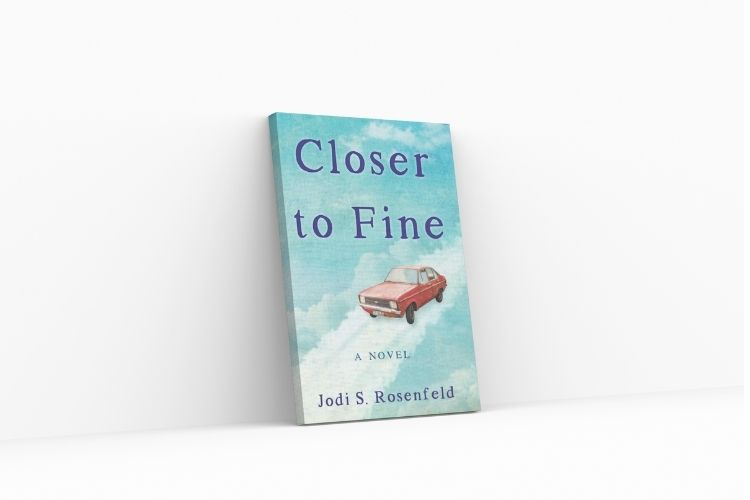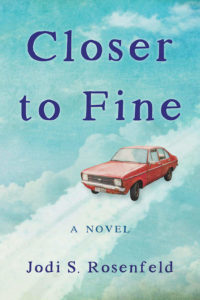
Young, Jewish and Bisexual in Fiction
In 1995, Rachel Levine—young, Jewish and bisexual—is attempting to navigate her professional, personal and spiritual life and faces significant challenges in all three arenas. Author Jodi Rosenfeld chats with Fiction Editor Yona Zeldis McDonough about Rachel’s journey as it is charted in her debut novel, Closer to Fine (She Writes Press).
YZM: You made a pivot from being a clinical psychologist to novelist; what has that been like?
JR: I actually don’t know if it was as much a pivot as it was a bridge. I’ve been practicing clinical psychology for twenty years, and in the fall of 2021, I’ll be starting rabbinical school full time at the Reconstructionist Rabbinical College. The shift from psychology to rabbinical school feels like a pivot, but it’s possible that writing this novel is what prepared me to do so, that it bridges the two. Closer to Fine is so much about psychology (learning to become a therapist and being in therapy) and Judaism (how to practice Judaism in a way that is authentically feminist and relevant.) I hadn’t thought of it quite this way before this moment, but the book is very much what ties these two passions together for me.

YZM: How do your training and experience figure into your writing?
JR: While the novel is not strictly autobiographical, it is very much based on my own training and experience. Like my protagonist, Rachel, I too came out as bisexual in college, struggled with finding feminist Jewish spaces (this is when I started reading Lilith!), and went to graduate school in psychology. Deciding to craft the story as fiction has allowed me to start with what’s familiar and move in new directions.
YZM: The novel is mostly set in the 1990s, and describes how Rachel is trying to find a different, less traditional path to being Jewish. What major changes have you seen in the intervening years? What other changes would you like to see happen in the future?
JR: This is a great question for me to be thinking about as I enter the Reconstructionist seminary. The book takes place on the eve of widespread internet use, and Rachel’s exposure to Jewish pluralism is indeed lacking. The only non-orthodox Jewish practices she’s been exposed to are through Conservative and Reform synagogues, and any feminist learning about new ways to experience her religious practice ended after college. Had she had access to the internet, she would have learned not only about newer Reconstructionist and Renewal congregations, but about alternative chavurot. Certainly, the decades since the 1990s have brought to center stage innovative and evolving kinds of Jewish practice, but I think the biggest change has been the ease with which we can access those practices and communities online. One thing the pandemic has brought to light is the ease with which we can participate in such a variety of Jewish communities. While my local congregation has been my home, I’ve also attended services in L.A. and classes in Chicago and even Israel! I hope that, as we move past the pandemic, we continue to immerse ourselves in Jewish experiences outside of our personal geographic spaces.
YZM: Let’s talk about Rachel’s relationship to her grandfather, which seems to represent a clashing of generations. Can you say more about that?
JR: Rachel and her zayde approach Judaism from different angles. Zayde is a long-time member of the Conservative movement and he sees his religion through a traditional lens. Rachel loves being Jewish and finds comfort in much of the tradition, but also yearns to experience her faith in ways that make her feel included as a queer woman, but also as one who questions traditional notions of a supernatural God. Their struggle is an age-old one of tradition vs. change. That struggle is complicated though by the fact that they love each other very much and are desperately afraid of losing one another. Ultimately, I think it is this fear, this anxiety, that holds them back from really openly communicating about their differences.
YZM: I also want to ask about Rachel’s bisexuality, because it creates a problem in her relationship with Liz.
JR: My experience of 1990’s sexual identity politics was that it was very siloed. You needed to pick a box and at that time, the boxes were straight, gay, or bi. The stereotype of bisexuals was that we were fence-sitters, unable to choose, and untrustworthy of being in a committed relationship. These stereotypes play out in the relationship between Rachel and Liz (who identifies as lesbian.) By creating this dynamic between them, I was hoping to illustrate some of the complexity of identifying with that in-between box. I assumed that this might be different today, that because sexuality is understood to be so much more fluid and because young people seem to understand their sexuality (and gender) as being more along a continuum, that the idea of the bisexual silo might not ring true with current twentysomethings. Interestingly, some of my younger early readers have told me differently, that despite the advent of many sexual identities, those who identify as bisexual often do still feel caught between two poles and distrusted as a result.



